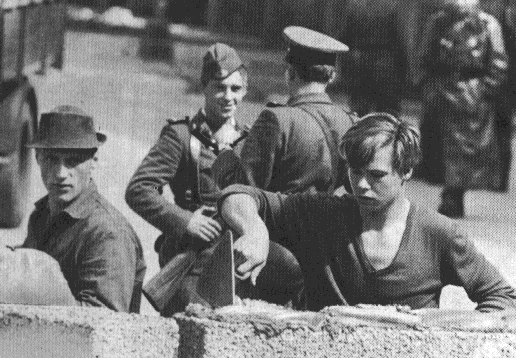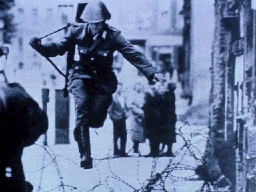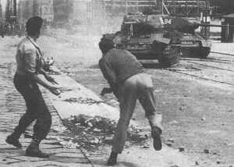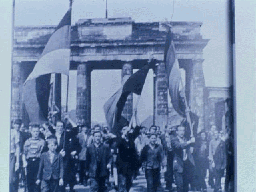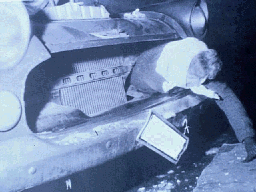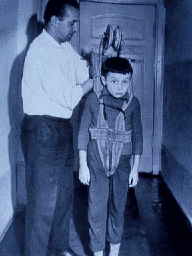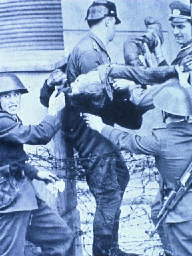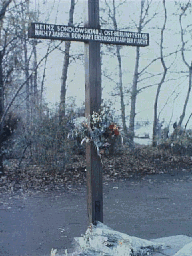Raising of the Wall
The Wall begins (left) with barbed wire, concrete blocks and mortar. A border guard (right) leaps the barbed wire to the West as the Wall is begun, 13 August 1961
In 1960, just as Kennedy was being elected, I returned to America. Less than one year later the Wall went up. Refugees had been pouring over at a rapid rate, sometimes thousands in a day. How did the Wall come about?
In June of 1961, Walter Ulbricht, the old head of the German Communist government said in an interview with a Western paper that no one had any intention of building a wall. Widely reported, this caused a massive exodus from the East. They knew then it was coming for sure. Thus, the Wall was constructed by the SED, the Socialist Unity Party of East Germany in August of 1961 as a protective wall against West German fascism and American capitalist imperialism. And for quite some time, it seemed to be working from the perspective of the East German government. It was really designed to give them breathing room by stopping the flood of refugees, many of them highly skilled and highly trained, to the West, and quell uprisings, like this one in 1953.
Workers rise against the SED Regime, East Berlin, 1953
Photo left courtesy of the © Deutsches Historisches Museum
Escape attempts...
Some East Germans escaped, but they were few. Every sort of invention imaginable was put to the test. People disguised themselves as Russian officers, dug tunnels, flew home made airplanes, packaged themselves as submarines. Here are a few examples, (left) a woman tucked in the front of a car, (right) a boy in a harness and pulley.Deaths at the Wall
Some made it out, some, but others, like Peter Fechter, (left) did not. He died at the Wall after being shot by guards. The last death was during the Spring of '89 at the site of this cross, (right).
![Poster showing Willy Brandt: slogan says, [Vote] SPD so that you can live in peace tomorrow as well](ber16.gif) West Berliners were outraged by the erection of the Wall. Willy Brandt, then mayor of Berlin, now grand old man of the SPD, West Germany's Social Democrats, was deeply impressed that the Americans and other Allies did nothing to prevent its construction. Brandt saw this moment as the start of his Eastern policy. A few years later, as Chancellor of West Germany, Brandt and other Social Democrats, opened a dialogue to engage the Russians. This was his Eastern Policy - Ostpolitik. Brandt reasoned that just turning away from them was impossible in the long run. The policies developed by the Social Democrats of tying the East in through commerce, loans, subventions, credits, and cultural exchanges worked brilliantly. Henry Kissinger picked up on this during the Nixon years, when it was called Detente. Later, when Carter and Reagan started the freeze all over again, Ostpolitik was a cornerstone of German policy, even for conservatives. Willy Brandt deserves major credit for opening up the East. West Berliners were outraged by the erection of the Wall. Willy Brandt, then mayor of Berlin, now grand old man of the SPD, West Germany's Social Democrats, was deeply impressed that the Americans and other Allies did nothing to prevent its construction. Brandt saw this moment as the start of his Eastern policy. A few years later, as Chancellor of West Germany, Brandt and other Social Democrats, opened a dialogue to engage the Russians. This was his Eastern Policy - Ostpolitik. Brandt reasoned that just turning away from them was impossible in the long run. The policies developed by the Social Democrats of tying the East in through commerce, loans, subventions, credits, and cultural exchanges worked brilliantly. Henry Kissinger picked up on this during the Nixon years, when it was called Detente. Later, when Carter and Reagan started the freeze all over again, Ostpolitik was a cornerstone of German policy, even for conservatives. Willy Brandt deserves major credit for opening up the East.
|
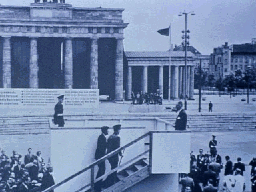 |  |
Beginning with Kennedy, every American president made
the trip to the Berlin Wall and demanded that it come down. | Red line through map of mass transit system shows division
of East and West Berlin |
It was so palpably there, so crass, 27 miles of Wall, through a city that belonged together. . It cut families apart, ruined lives. It was so unnatural,so wrong.
The border between East and West Germany
still in late '89 the most heavily secured border in the world;
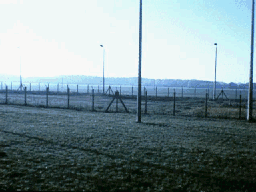
everywhere along its length, as in this section next to the railway
from Berlin to Hamburg, barbed wire, mine strips, lights, towers,
automatic guns, guards, dogs.
Options:
For Student Exercises in English and German to Part 3 click here!Proceed to Part 4. West Berlin thrives or, switch to another Part:
1. Berlin at the End of WW II
2: The First Postwar Decade
3. The Raising of the Wall
5. East Berlin, a tourist attraction
6. East Germany during the Wall
7. Bringing down the Wall from within
8. East meets West
9. East German Problems
10. The Road to Unification
11. Return to Index 